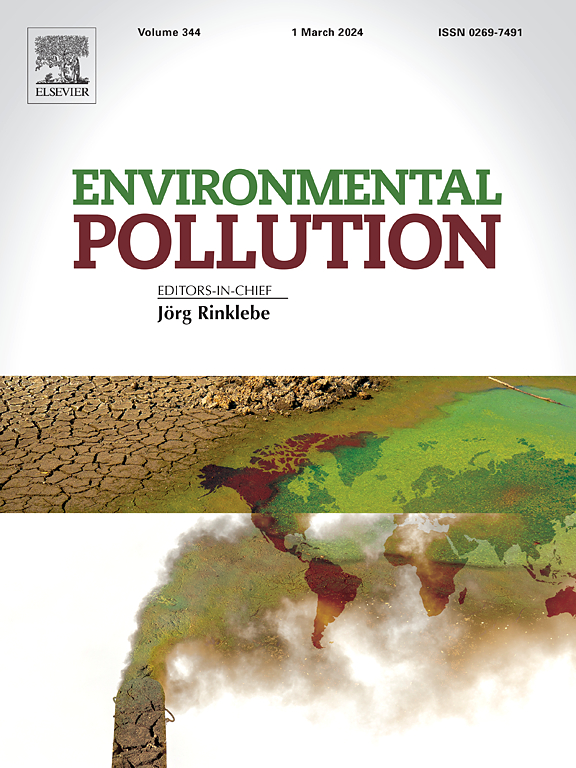太原市孕产期暴露于室外颗粒物(PM1、PM2.5、PM10)和SO2对学龄前儿童肺炎的影响
IF 7.6
2区 环境科学与生态学
Q1 ENVIRONMENTAL SCIENCES
引用次数: 0
摘要
目前,关于生命早期暴露于不同大小组分的颗粒物(PM)对学龄前儿童肺炎的影响的研究很少。本文对太原市4814名子代儿童进行了产前和产后大气污染物与诊断肺炎之间的关系研究。采集室外空气污染物浓度和环境温度。使用基于机器学习的模型计算家庭住址的PM10, PM2.5和PM1的每日平均值。使用广义线性混合模型计算关联,并使用交替分析来检测敏感亚群。我们观察到产前暴露于大气污染物和儿童肺炎发病率之间的关联。妊娠期PM10、PM2.5、PM1、SO2的比值比分别为1.06、1.15、1.24和1.05,每增加10 μg/m3。在怀孕中期,PM10、PM2.5和PM1暴露是最重要的联系。女孩对PM2.5和PM10的敏感度更高。在高二氧化硫暴露时观察到PM与肺炎之间最显著的联系。在家中没有环境烟草烟雾(ETS)的儿童中,PM1、PM2.5与肺炎之间的联系更强。在家中有ETS的儿童中,PM10与肺炎的相关性更强。综合数据表明,怀孕期间暴露于PM10、PM2.5、PM1和SO2会增加儿童肺炎的易感性。妊娠中期非常重要,是脆弱的关键时期。PM1的影响最大。暴露于二氧化硫可进一步增加与PM相关的肺炎风险。性别和家中接触ETS可改变室外PM与肺炎之间的关联。中国需要进一步减少室外可吸入颗粒物,特别是可吸入颗粒物1,以减少儿童肺炎。本文章由计算机程序翻译,如有差异,请以英文原文为准。

Effect of pregnancy and infancy exposure to outdoor particulate matter (PM1, PM2.5, PM10) and SO2 on childhood pneumonia in preschool children in Taiyuan City, China
There is currently a paucity of research on the effects of early life exposure to particulate matter (PM) of various size fractions on pneumonia in preschool-aged children. We explored the connections between antenatal and postnatal atmospheric pollutants and diagnosed pneumonia among 4814 offspring children in Taiyuan City, northern China. Outdoor air pollutant concentrations and ambient temperature were collected. A machine learning-based model was utilized to compute daily means of PM10, PM2.5, and PM1 at the home address. Associations were calculated using generalized linear mixed models, and alternate analysis was used to detect sensitive subpopulations. We observed an association between prenatal exposure to atmospheric pollutants and the incidence of pneumonia in children. For every 10 μg/m3 increase, the odds ratios (ORs) were 1.06 for PM10, 1.15 for PM2.5, 1.24 for PM1 and 1.05 for SO2 for the whole pregnancy period. In mid-pregnancy, the most vital connections were found for PM10, PM2.5, and PM1 exposure. Girls showed higher sensitivity to exposure to PM2.5 and PM10. The most significant connections between PM and pneumonia were observed at high SO2 exposure. Connections between PM1, PM2.5 and pneumonia were stronger in children without environmental tobacco smoke (ETS) at home. Associations between PM10 and pneumonia were stronger in children with ETS at home. The synthesis of the data suggests that exposure to PM10, PM2.5, PM1, and SO2 during pregnancy contributes to an elevated susceptibility to childhood pneumonia. The second trimester period is significant and represents a critical window of vulnerability. PM1 can have the strongest impact. Exposure to SO2 can further enhance the PM related risks of pneumonia. Gender and ETS exposure at home can modify associations between outdoor PM and pneumonia. Further reduction of outdoor PM, especially PM1, is needed in China to reduce childhood pneumonia.
求助全文
通过发布文献求助,成功后即可免费获取论文全文。
去求助
来源期刊

Environmental Pollution
环境科学-环境科学
CiteScore
16.00
自引率
6.70%
发文量
2082
审稿时长
2.9 months
期刊介绍:
Environmental Pollution is an international peer-reviewed journal that publishes high-quality research papers and review articles covering all aspects of environmental pollution and its impacts on ecosystems and human health.
Subject areas include, but are not limited to:
• Sources and occurrences of pollutants that are clearly defined and measured in environmental compartments, food and food-related items, and human bodies;
• Interlinks between contaminant exposure and biological, ecological, and human health effects, including those of climate change;
• Contaminants of emerging concerns (including but not limited to antibiotic resistant microorganisms or genes, microplastics/nanoplastics, electronic wastes, light, and noise) and/or their biological, ecological, or human health effects;
• Laboratory and field studies on the remediation/mitigation of environmental pollution via new techniques and with clear links to biological, ecological, or human health effects;
• Modeling of pollution processes, patterns, or trends that is of clear environmental and/or human health interest;
• New techniques that measure and examine environmental occurrences, transport, behavior, and effects of pollutants within the environment or the laboratory, provided that they can be clearly used to address problems within regional or global environmental compartments.
 求助内容:
求助内容: 应助结果提醒方式:
应助结果提醒方式:


